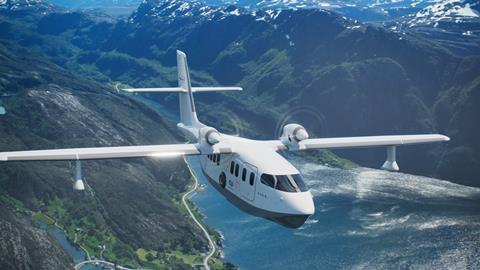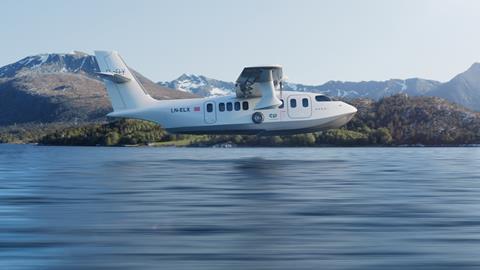The designers of an all-electric seaplane called NoEmi hope their conceptual aircraft will one day take tourists fjord-hopping in Norway, and eventually connect cities in coastal areas worldwide.
Norwegian start-up Elfly Group’s engineers started with some 300 design concepts for NoEmi – including radical six- and 10-propeller configurations – but narrowed their focus to a twin-motor nine-seat aircraft powered by lithium batteries and an electric power plant. It may look familiar because it is inspired by proven seaplanes.

A rendering of Elfly’s conceptual seaplane NoEmi
“It is a flying boat much like a [Grumman G-73] Mallard, and it has some of the features of the [De Havilland Canada DHC-6 ] Twin Otter,” Eric Lithun, founder and chief executive of Elfly, told FlightGlobal last month during the Paris air show in Le Bourget.
The amphibious NoEmi’s design was revealed last month in Oslo, with the company touting that its boat-inspired hull will allow for take-off with “very little power”.
The company hopes to produce a larger, 19-seat variant of its yet-to-be-certificated NoEmi, which stands for “no emissions”, and variants modified for cargo and medevac operations. The eventual production aircraft will cruise at 135kt (250km/h) and have range of 108nm (200km), optimised for short trips between Norway’s fjords, lakes and coastal cities.
“But since we are the first customer, we aren’t lying to anybody – we have today a range of 170km and we are struggling to get to 200km,” Lithun says. “But that is with today’s battery tech, without complete science fiction or any magic powder.”
By planning to fly fewer than 10 passengers, Elfly’s operations would be exempt from airport security screenings. Like other regional air mobility (RAM) companies, it theorises that streamlined boarding will save passengers time travelling between city centres, and that flying electric aircraft will keep operational costs relatively low.
Advert
Industry analysts observe that plenty stands to prevent RAM start-ups from taking off, however. Such companies are banking on rapid advancements in battery technology, and have tasked themselves with developing vehicles and regional transportation systems that beat existing options.
A 31 May report from management consultancy McKinsey found that “battery energy density will need to at least double today’s density for the RAM market to meet its full potential”.
NoEmi’s development is at the “end of the conceptual phase”. Next it will build a 20% scale model, which it hopes to validate over the summer before building several full-scale prototypes for certification testing. The company plans to fly a prototype in 2025, clear certification by 2029 and begin carrying passengers the following year with a fleet of about 15 seaplanes.
Tomas Brodreskift, Elfly’s chief technology officer, admits during the same interview in Le Bourget that the 2030 timeline is “relatively aggressive planning”, as it typically takes 10 years to develop and produce a clean-sheet aircraft. “Even though the plane is pretty normal, you have to do some serious work on the material technology if you want to integrate a new drive train into a new airframe.”
SEAPLANE FLEET BY 2030?
Founded in 2018, Bergen-based Elfly is focused on building a business model as much as building aircraft. “I always say we need to love the business case and like the product,” Lithun says. “If you are making a product for the existing industry, they are like, ‘Why do you build a seaplane? Nobody wants a seaplane.’ Well, if the business case is good, everybody wants to do it.”
As Elfly plans to pursue an operating certificate and bring the first of its aircraft into service, the start-up is taking a close look at use cases. NoEmi’s limited range makes it a good candidate for short-haul flights between Norway’s coastal city centres, such as Bergen to Stavanger. Floro, Leirvik and Stryn are also targets for its early network.
The start-up will likely focus initially on flying tourists, but Lithun sees coastal residents and workers in the gas, fishing and hunting industries as potential passengers. It will initially provide flights between city centres, then possibly expand to more remote locations.
“Most of the Norwegian population lives close to a potential momentary runway,” the company says on its website. ”Due to Norway’s mountainous profile and the limited connecting infrastructure, the seaplane is a quick, non-intrusive way of transporting people over challenging terrain. Hours spent in a car between small cities could be reduced to minutes.”

Source: Elfly Group
NoEmi is designed to seat nine passengers, and to be modified for cargo and medevac variants
The company envisions developing a ride-sharing app to facilitate smooth transitions from buses, trains and commercial airlines. Lithun imagines something like UberPool, which picks up multiple riders heading in the same direction. He hopes electric seaplanes will be embraced as a new mode of public transportation, similar to Norway’s fleet of electric ferries, as the programme could advance the Norwegian government’s goal of eliminating carbon emissions from domestic aviation by 2040.
Advert
Elfly estimates that producing the aircraft’s first prototype will cost roughly €20 million ($22.5 million), and that the entire development programme could cost up to €200 million, including certification costs and building out production capabilities.
The project is mostly self-funded, as Lithun previously owned and sold an information technology start-up, and also has support from the Research Council of Norway.
The company is beginning the process of certification “before we build anything… because the business case requires a certified plane”, Lithun says.
But technical issues must be addressed before NoEmi is certificated by Luftfartstilsynet, the Civil Aviation Authority of Norway. For example, Elfly’s plan to mount the battery pack below the seaplane’s waterline creates a problem.
Advert
“The rules state you need five or six waterproof sections, so you can get a hole in two of them and the plane will still float,” Brodreskift says.”How do you deal with that when you have a battery pack in there?”
“You have to discuss it with them and see if there is a way this can be certified,” he says of working with regulators. “And if they say no to that, it is going to be a challenge.”
FLOATING AIRPORTS
Unlike electric vertical take-off and landing aircraft (eVTOL), Elfly says, NoEmi could potentially fly passengers to city centres without changes to regulations, air traffic control or infrastructure.
Elfly is mostly banking on plugging into existing charging systems.
“In Norway, there are more and more small electric boats… and they have charging systems by the docks,” Lithun says. “We want to use the same charging systems as cars and those boats.”
The outfit wants to create a last-leg transportation system based on its electric seaplanes and “floating airport systems”. The concept is to have multiple floating modules to support check-in and boarding that can be easily rearranged and moved.
“Docking the seaplane is the most dangerous part of any seaplane operation,” Brodreskift says, as docks often damage aircraft moved suddenly by wind and waves. “Our designs are trying to find a way to make these docks maybe adjust to the wind and help the pilot make [docking] easier.”
Challenges certainly will come along with operating electric aircraft in salt water, as corrosion is a major issue with existing seaplanes. Notably, NoEmi’s carbon-fibre airframe will not corrode in maritime operating conditions.
“Salt water and [electric] power is a bad thing, right? But I would state that it’s solvable, especially when you see these 74 ferries going around in the fjords, and they are charged with a lot more power than we are going to use,” Lithun says. “We will try to use standardised equipment from the EV industry.”
Other companies are developing electric-powered marine aircraft. Rhode Island’s Regent Craft, for instance, is working on an all-electric wing-in-ground-effect vehicle. Canada’s Harbour Air has flight tested a DHC-2 Beaver seaplane modified with electric propulsion and hopes one day to have a fleet of electrified seaplanes.
Once the aircraft proves safe, scaling production would be the next challenge. In the long run, Elfly hopes to expand operations to other coastal areas – noting that most of the world’s population lives by the ocean – and perhaps attract attention from major airframers interested in producing NoEmi at a larger scale.
The company recently selected US battery-maker Electric Power Systems to provide the batteries for its test aircraft, but has yet to identify a supplier for NoEmi’s electric engines.
As Elfly starts down the path to certification and production, the start-up senses Norwegian aviation regulators are “happy to see planes that are more conventional”, Brodreskift says. He believes that is because, in contrast to otherworldly eVTOL designs, NoEmi simply looks the part of a passenger seaplane.

Source: Elfly Group
NoEmi is planned for service entry in 2030

